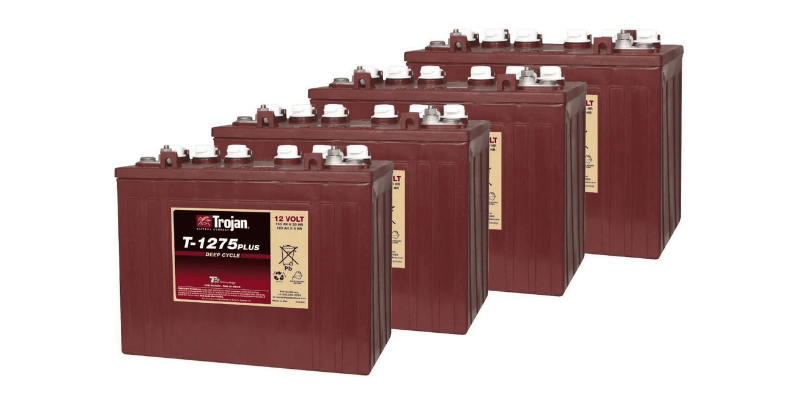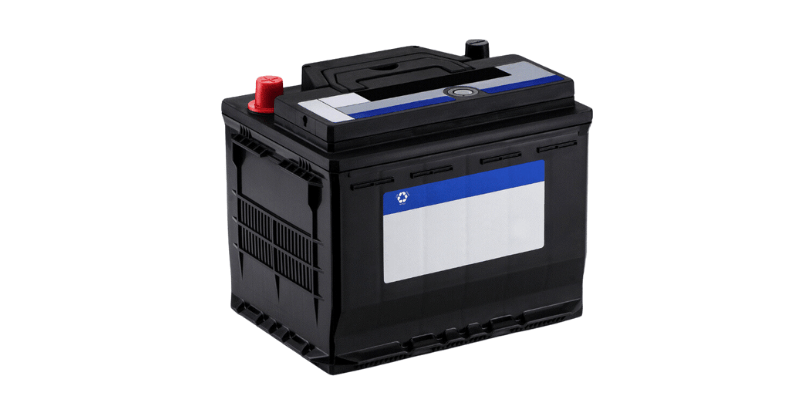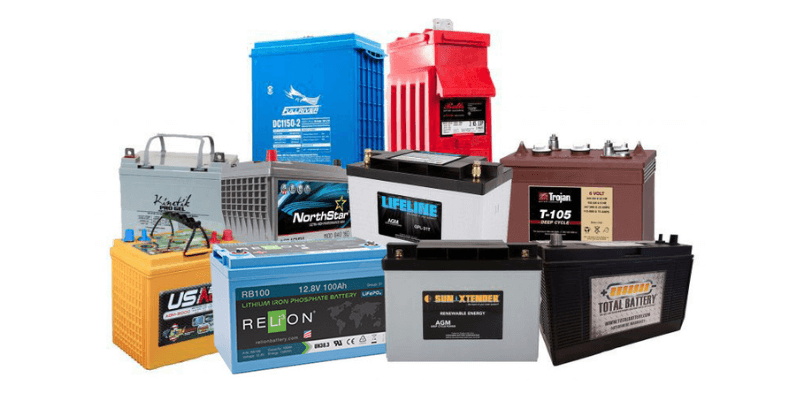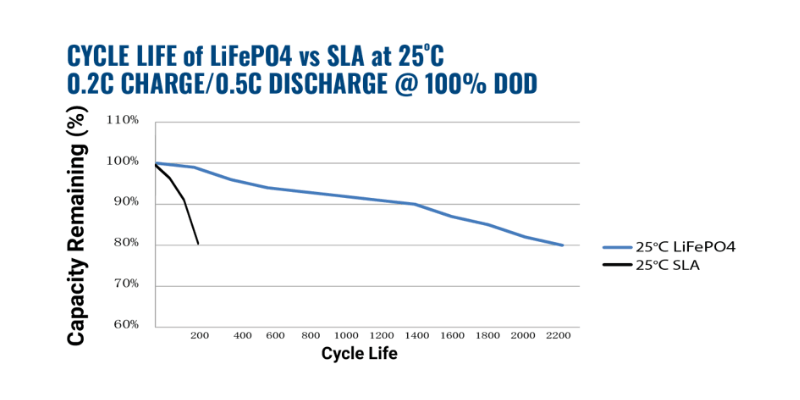Innan du diskuterar djupa cykelbatterier är det viktigt att förstå batteriets grunder, till exempel cykler och Djup för urladdning (DOD).
En cykel är en full urladdning och laddning av ett batteri. DOD mäter kapaciteten som används under urladdning, med 100% DOD som är lika med en full urladdning.
State of Charge (SOC) återspeglar den återstående laddningen, där 100% DOD motsvarar 0% SOC. En djup urladdning inträffar när 80% till 100% av kapaciteten används.
Vad är ett djupt cykelbatteri?
Ett djupt cykelbatteri är utformat för kontinuerliga djupa urladdningar på 80-100% DOD. Högklassiga batterier kan hantera några djupa cykler om utlopps- och laddningshastigheter följs strikt, men upprepad djup cykling kan få dem att misslyckas med tiden. Tillverkare rekommenderar vanligtvis att de inte släpper ut under 45% till Förläng batteriets livslängd.

Typer av djupa cykelbatteri
Det finns flera typer av djupa cykelbatterier, var och en med distinkta material, fördelar och nackdelar.
Översvämmad bly-syra (FLA)
Det översvämmade blysyrabatteriet, den äldsta typen som fortfarande används, känd som en våt cell med en vätska elektrolyt. Det kräver ofta vattentillägg och måste förbli upprätt på grund av vätgasgasproduktion. Underhållet är högt och involverar vattentillägg och rengöring av syrarester. Deras popularitet har minskat på grund av vikt och underhållsbehov.
Ventilreglerad bly-syra (VRLA)-Gel- och AGM-batterier
Dessa bly-syrabatterier använder gelade elektrolyter eller absorberad glasmatta, vilket eliminerar behovet av vattentillägg. De är dyrare än översvämmade batterier men har ofta kortare livslängd i krävande applikationer. De kräver inte upprätt lagring och minskar korrosionsriskerna.

Litiumjonbatterier
Betraktas framtiden för djupa cykelbatterier, de behöver inget underhåll, kan släppas djupt utan skador och laddas snabbt. Även om deras högre initialkostnad kan avskräcka vissa användare, överträffar de bly-syrabatterier på lång sikt och erbjuder många fördelar som att vara lätt och upprätthålla kraft under urladdningscykler.
Deep Cycle Battery Applications
Innan du väljer ett batteri ska du bestämma vad som måste drivas, hur länge, hur ofta och den erforderliga strömmen. Djupa cykelbatterier är lämpliga för cykliska applikationer där användare styr när batteriet används.
Till exempel förlitar sig en medicinsk vagn bort från ett utlopp på batteriets kraft medan den är kopplad. Sjuksköterskan eller läkaren aktiverar det dagligen och kräver konsekvent långsiktig kraft – En djup urladdningsanvändning som kräver ett djupt cykelbatteri. På liknande sätt ger mobiltelefonbatterier hela dagen på en enda laddning och används dagligen. Användare väntar vanligtvis tills deras telefon är helt urladdad innan de laddas (100% DOD/SOC 0%). Denna konsekventa efterfrågan kräver också ett djupt cykelbatteri.

Djup cykelteknologi gäller också marin användning, husvagnar, mobilitetsskoter, elfordon och solsystem.
Omvänt serverar högklassiga batterier back-up-roller i nödsituationer. Till exempel använder hissar dessa batterier för att leverera energi snabbt under kraftfel men kan behöva ersättas före användning. Ett högklassigt batteri fungerar som en försäkring för plötsliga krav på energi medan djupa cykelbatterier ger tillförlitliga vardagliga prestanda.
Hur länge kommer ett djupt cykelbatteri att hålla?
Livslängden för ett djupt cykelbatteri beror på flera faktorer, med bly-syrabatterier som är mer benägna att skada än litium.
Korrekt underhåll, korrekt laddning och urladdningspraxis kan hjälpa till att förlänga batteriets livslängd. Ledsyrabatterier påverkas negativt av felaktig vattning, överladdning, överladdning och underladdning, vilket minskar deras livslängd avsevärt. Å andra sidan kräver litiumbatterier inte vattning och påverkas inte av partiellt laddningstillstånd eller underladdning. Många litiumbatterier är utrustade med en smart Batterihanteringssystem (BMS) Det förbättrar batteriskyddet och livslängden.
Dessutom påskyndar högre temperaturer nedbrytning av batteriet.
När det gäller genomsnittlig livslängd överlever litiumjärnfosfatbatterier vanligtvis bly-syrabatterier, med över 2000 cykler jämfört med 200 cykler. Litiumbatterier upprätthåller kapacitet oavsett urladdningshastighet, vilket gör dem överlägsna för djupa cykelapplikationer. Det är viktigt att överväga antalet cykler som ett batteri kan uthärda snarare än bara tid att mäta dess livslängd exakt.

För djupcykelapplikationer där urladdningshastigheterna överstiger 0,1C (Vad är en C -hastighet?), ett litiumbatteri med lägre kapacitet överträffar ofta ett motsvarande bly-syrabatteri. För att bestämma kapaciteten för ditt batteri, hänvisa alltid till tillverkarens specifikationer.
Vilket djupt cykelbatteri har mer kapacitet?
Kapaciteten varierar avsevärt mellan bly-syra- och litiumbatterier på grund av deras olika kemi. Litiumbatterier levererar upp till 100% av sin nominella kapacitet vid valfri urladdningshastighet, medan bly-syrabatterier ger mindre användbar energi vid högre urladdningshastigheter.
Båda typerna tappar kapacitet i kallt väder, men litium presterar bättre. Till exempel sjunker ett bly-syrabatteriets kapacitet med upp till 50% vid 0 ° C, jämfört med en förlust på 10% för litiumjärnfosfatbatterier.
Hur man laddar ett djupt cykelbatteri
För att maximera ditt djupa cykelbatteriets livslängd och prestanda, ladda det korrekt. Korrekt laddning beror på batteriets kemi, spänning och kapacitet. Holo Battery erbjuder en guide om hur man laddar ett litiumdjup cykelbatteri. Att följa denna riktlinje hjälper till att säkerställa att ditt batteri varar längre.
Djupa cykelbatterier vs startbatterier
Djupa cykelbatterier är som maratonlöpare, vilket ger en stadig strömförsörjning under långa perioder, idealisk för att driva elektronik på båtar eller husvagnar. Däremot är startbatterier som sprinter, som snabbt släpper ut hög effekt för att starta fordonsmotorer. Batterier med dubbla ändamål kombinerar båda funktioner och erbjuder korta spridningar av kraft och kontinuerlig utbud i en enda enhet.

